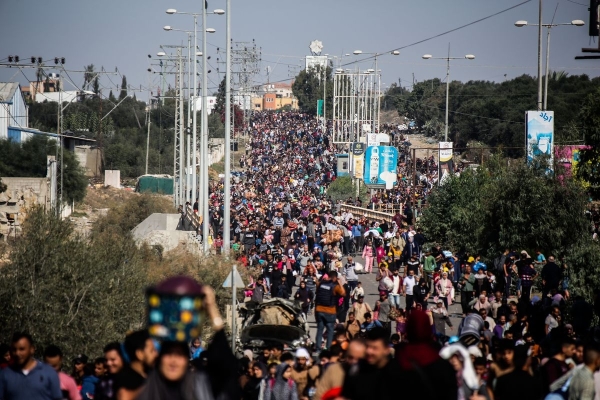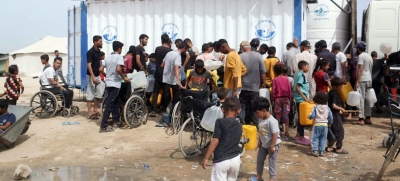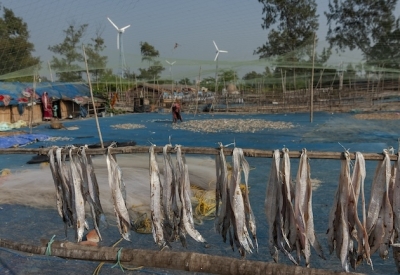Israel has agreed to four-hour daily humanitarian pauses in areas of northern Gaza as US officials announced Thursday. The pauses, meant to allow civilians to safely leave for southern Gaza, comes amid an increasingly dire humanitarian crisis as Israel continues to bombard one of the most densely-populated places on the planet.
The windows have so far allowed 100,000 people to move, according to Israeli officials — but it’s not clear that the safe routes and pauses are enough as more than 11,000 Palestinians have been killed and calls for a ceasefire grow louder.
The new agreement is the result of US pressure on Israeli Prime Minister Benjamin Natanyahu, with National Security Council spokesperson John Kirby telling reporters that the new policy is due to President Joe Biden’s “personal leadership and diplomacy.” But Biden was apparently unable to secure the more prolonged ceasefire he sought to secure the release of hostages, Politico reported Thursday. The US continues to supply military aid to Israel, as it has for decades, and Biden has requested an additional $14.3 billion to finance Iron Dome and other air and missile defense systems.
US officials expect that the daily pauses will also allow for increased humanitarian aid to enter Gaza, as residents have received only a fraction of the basic goods via aid organizations that they did previous to the war. Israel has blockaded Gaza for the past 16 years, since Hamas took control of the territory, and food, medicine, and fuel are supplied by the United Nations and other agencies.
While pauses offer some measure of safety for people fleeing Israel’s operations in northern Gaza, the totality of the humanitarian crisis there remains overwhelming. More than 11,000 Palestinians have been killed by Israeli forces over the past month of fighting in Gaza, and supplies like food, clean water, and fuel are dangerously limited in the south, where some 2 million people are expected to shelter as Israel prosecutes its war against Hamas.
Over the past three weeks Israel conducted overnight raids and bombing campaigns in northern Gaza before launching a phased assault. The Israel Defense Forces announced earlier this week that it had encircled Gaza City, the northern population center it has deemed the center of Hamas operations.
On Friday, just a day after the humanitarian pauses were announced, fighting broke out around hospitals in Gaza City, including at al-Shifa hospital, where hundreds of gravely ill and wounded patients are being treated and thousands of civilians have been sheltering — putting them in serious danger and casting doubt on the efficacy of the humanitarian pauses.
Getting people out, getting aid in
Israel initially gave the estimated 1 million people living in the northern part of the Gaza Strip 24 hours to evacuate to the south so that it could prepare to conduct military operations there, including launching airstrikes and destroying tunnels used by Hamas.
The original evacuation demand, according to several humanitarian organizations including the UN, was impossible to execute, particularly given the ongoing combat, poor infrastructure damaged by previous conflict, lack of fuel for cars given the siege Israel declared on the territory starting October 9, and sheer number of people moving within one of the most densely populated places on earth.
Hundreds of thousands of Palestinians have moved to the south since that initial call for evacuations, though thousands remain, many sheltering at hospitals like al-Shifa near Gaza City.
Details about the location and time of the pauses are unclear, as is the number of days the pauses will occur but Kirby told reporters Thursday that the timing of the pauses will be announced three hours prior to their beginning each day.
Following Defense Minister Yoav Gallant’s call for a siege on Gaza, aid groups as well as governments like Qatar and the US have tried to negotiate for aid to come into the territory through the Rafah crossing on Gaza’s southern border with Egypt. The siege meant that no food, medicine, medical equipment, potable water, or fuel could get into the territory; electricity and, at times, telecommunications were cut as well. Without electricity or fuel, Gaza’s water desalination plants cannot produce potable water, and hospitals can operate in only limited capacities despite the critical need for health services in a war zone.
Since October 9, negotiations have allowed for some aid to get through — about 100 trucks of supplies per day, according to Special Envoy for Middle East Humanitarian Issues David Satterfield, compared with around 500 per day prior to the war. “Now, we understand even 150 trucks a day just meets the bare minimum to provide basic survival humanitarian assistance,” Satterfield said in a press briefing Thursday. “Much more is needed beyond that. There needs to be commercial goods restocking shelves, bakeries need to reopen with all that they need in terms of supplies, cooking gas for that purpose.”
Satterfield also told reporters that fuel stores in southern and central Gaza had been made available via the UN Relief and Works Agency for Palestine Refugees in the Near East (UNRWA) and were supplying water desalination facilities in south and central Gaza, and two water pipelines from Israel had been restored.
The bigger picture: Gaza is still being devastated, and it’s only getting worse
Thus far in the fighting more than 11,000 people have been killed according to the Gaza Health Ministry; more than 4,500 are said to be children and over 3,000 women, the UN Office for the Coordination of Humanitarian Affairs (OCHA) reported in a bulletin from November 10. “On average, a child is killed every 10 minutes in Gaza,” Tedros Adhanom Ghebreyesus, head of the World Health Organization, said in a Friday briefing to the UN Security Council.
IDF airstrikes and operations remain the major cause of death and casualties; though the military says it is targeting Hamas terrorists, 90 percent of the casualties are civilians when explosives are used in populated areas, according to the UN. The IDF has conducted multiple operations in the Jabalia refugee camp in Gaza, calling it a Hamas stronghold and “hotbed of terrorist activity,” according to IDF spokesperson Lt. Col. Jonathan Conricus. “Nobody can claim that they didn’t know this was coming,” he said, emphasizing that residents had been told to evacuate for two weeks.
On Saturday, fighting near hospitals in Gaza including al-Shifa continued, causing chaos and panic. The IDF has commanded the evacuation of al-Shifa hospital, saying that Hamas operates in tunnels beneath the facility, which both Hamas and hospital leadership deny. Al-Shifa has about 700 beds, but is currently treating 5,000 people, according to Medecins Sans Frontieres. Hamas claims the hospital is sheltering around 40,000.
Reports of heavy bombardment at al-Shifa continued Friday night and into Saturday. “The situation in al-Shifa is truly catastrophic,” Ann Taylor, head of mission in the Occupied Palestinian Territories said in a statement. “We call on the Israeli Government to cease this unrelenting assault on Gaza’s health system. Our staff and patients are inside Al-Shifa hospital where the heavy bombing has not stopped since yesterday.” MSF staff reported constant bombardment and people being shot as they tried to leave the hospital.
“There is no siege, I repeat no siege, on Shifa Hospital. The east side of the hospital is open for the safe passage of Gazans who wish to leave the hospital,” IDF spokesperson Daniel Hagari said in a Saturday briefing.
“We’re speaking directly and regularly with the hospital staff. The staff of Shifa Hospital has requested that tomorrow we will help the babies in the pediatric department to get to a safer hospital. We will provide the assistance needed,” Hagari said. Two babies in the neonatal unit died after the hospital ran out of fuel Saturday, according to the BBC.
And though more than 850,000 people have left northern Gaza so far according to the IDF, “Hundreds of thousands of people remaining in the north are struggling to survive,” OCHA reported. “Consumption of water from unsafe sources raises serious concerns about dehydration and waterborne diseases. The World Food Programme (WFP) has expressed concern about malnutrition and starvation.”
In the midst of the ongoing devastation, French President Emmanuel Macron on Friday called for a ceasefire in an interview with the BBC. “There is no other solution than first a humanitarian pause, going to a ceasefire, which will allow [us] to protect... all civilians having nothing to do with terrorists.”






